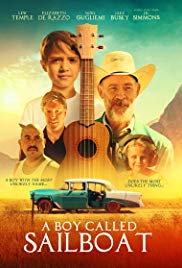Movie review by Andrea Karen Hammer
A few rare movies have the power to create their own category. They are pure gold unexpectedly mined from the dusty earth.
Based in the barren desert with lone cars kicking up clay dirt, A Boy Called Sailboat captivates from the start. As the 8-year-old boy Sailboat, Julian Atocani Sanchez‘s impish face and boyish narration filled with old-soul wisdom are riveting. When he discovers a hand-crafted pint-sized guitar in a trash heap, his musical gifts attract growing crowds to his Hispanic family’s isolated and rickety home.
Powerful Performances in Spare and Often Silent Scenes
Barely held up by a stick that the family watches vigilantly, the house frames spare and largely silent scenes around the dinner table. Noel Gugliemi as the father, Jose, captures the tough-guy demeanor to sometimes frightening proportions. Always seeming to verge on cracking someone’s head open, he teaches a boy who breaks his son’s guitar strings a memorable lesson during a subtly humorous scene.
Allowing moments of tenderness for his son and wife to slip through his hardened and tattoo-covered exterior, Noel Gugliemi masterfully conveys fierce love for his family. As the generally mono-syllabic and people-shy wife, Meyo, Elizabeth De Razzo is equally protective of her son whose increasingly popular outdoor concerts prompt her to cook spicy meatballs for the growing crowd outside their door.
J.K. Simmons’ cameo role as the three-car and single-sailboat salesman, Ernest, offers a study in contrasts. Viewers watch, with delight, as he practices his sales spiel on the little boy who is silently staring up with longing at the sailboat.
Children’s Wide-Eyed Wonder and Simply Delivered Wisdom
With individual charm, the other children in the movie imbue the film with a sense of wide-eyed wonder and simply delivered wisdom. As they are drawn to Sailboat’s music in between attending school and playing soccer, the movie’s pacing meanders back to its star Julian Atocani Sanchez–walking on foot to reach his grandmother in the hospital.
Along with Sailboat’s touching example of keeping his promise to play her a song, evocative scenes and thought-provoking observations about different types of quiet make a memorable mark. Watching adults dissolve into tears as Sailboat plays and others line up for his performances are reminders of the awe-inspiring talents of those with natural gifts.
The lasting messages from A Boy Called Sailboat, which continue to resurface, are the universal language of music as well as its power to comfort, heal and connect.
Questions for Artsphoria’s Online Film Forum
Why were viewers not permitted to hear Sailboat’s music–and only black noise–during most of the film? What were the reasons for simply showing how others responded during the performances? What other scenes and film-making techniques did you find notable, and why?
Contribute to this movie review, and post your comments. Then, spread the word about Artsphoria’s Online Film Forum, and watch for film news on Artsphoria International Magazine.





